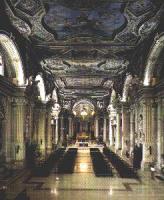|
|
The churches express the Este family's search fora suitable burial place |
|
|
|
|
In 1663 the wife of the deceased duke Alfonso IV had the old church of Sant'Agostino (on the square of the same name) enlarged and generally transformed, with the aim of creating an Este Pantheon in which the family's tombs could be placed. The church, which stands beside the Palazzo dei Musei, has a very sober brick facade, and the only traces of the original church now remaining are the hanging arches and saw-tooth and T-shaped brick decoration on its left-hand side. The interior, as decorated by the Este family in the mid XVII Century, is clearly calculated to give an impression of grandeur, with the length of its single nave underlined by the panelled ceiling, all painted with subjects intended to glorify the Este family. The elegant tranquillity of the interior is accentuated by the light which flows in through the large windows on both sides and in the apse; the atmosphere of light is reinforced by the large amount of plasterwork imitating the white of marble, and also by the shining floor. The effect of perspective means that the side chapels tend to be overlooked, but the splendour of their decorations comes into view gradually as one walks towards the altar. 
However, the intentions of Duchess Laura Martinozzi were overruled at a later date, and the status of Pantheon of the Este family passed to the church of S. Vincenzo, in Corso Canalgrande. Its imposing facade, surmounted by a triangular pediment, is decorated with marble columns and false pilasters that stand out against the brick background. Like S. Agostino, S, Vincenzo has a single nave and is very well lit by the windows on both sides and around the dome. But while in S. Agostino the impression is of luxury tempered by elegance, the interior of S. Vincenzo gives a colder feeling of expanses of emptiness. Towards the altar, the tombs of some members of the Este family, decorated with marble sculpted with unemotional polish, add to an atmosphere of sepulchral solemnity. A door on the right at the far end of the church gives access to the family vault, constructed later, in 1838, where 16 dukes are buried. |
|
© 1997 - Provincia di Modena - Made by
|
|